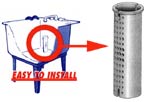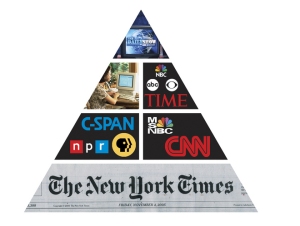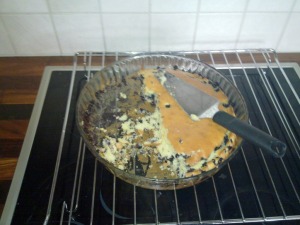30-Second Word Whoop: “Orbit”
Love those Orbit gum ads. Kinda loopy, right?
Quite possible those creatives were smoking falafel to come up with their “Falafel” ad concept. Definitely an international flavor to this gum. Or shall we say “universal”? (See “Taco” or “Kabob” or any number of globular comfort foods served up from this marketing buffet.)
Although “orbit” is a far-out term, referring to “the path of a celestial body or an artificial satellite as it revolves around another body” or even “one full revolution of that body,” it is a perfect example of how the cosmos mirrors a body’s microcosm.
 “Orbit” also refers to each bony socket of the skull that holds our eyeballs. (Or in reference to other animals, it is the skin surrounding the eye of a bird … or the hollow in which lies the eye or eyestalk of an insect or other arthropod.)
“Orbit” also refers to each bony socket of the skull that holds our eyeballs. (Or in reference to other animals, it is the skin surrounding the eye of a bird … or the hollow in which lies the eye or eyestalk of an insect or other arthropod.)
It’s from the Latin orbita, or “course,” and orbis meaning “circle” or “orb.” That alone sounds spacey.
On an atomic level, it is the path of an electron in its motion around the nucleus of an atom. Beyond the physical, “orbit” can define any observable range of activity, experience, or knowledge. It’s also apparently a video game.
Add a “z” to get Orbitz, the online travel company that invites you to circumvent the globe and add to your range of activity, experience and knowledge. Just be sure to pack a pack of Orbit gum to take care of any foreign food particles lingering behind.
What goes around comes around.
Related articles
- Orbit Girl Returns With More Talking Food (adrants.com)
- Orbit Gum Helps You Vanquish Giant Annoying Talking Meat and Potatoes (adweek.com)
30-Second Word Whoop: “Trap”

Remember the board game “Booby-Trap” from the Sixties-Seventies? If you do, you may have a mind like a steel trap. (Photo courtesy of Phil Romans, Flickr)
“It looks like a trap!”
“Shut your trap.”
“He bears the trappings of a fool.”
None of these machinations of “trap” is an open-shut case. First off, identifying a trap would defuse its power. In case two, your free will defies such a command. In the third usage, the meaning is “disguised”: Trappings might say one thing and reveal another.
 Sometimes a trap is a good thing. A lint trap protects your dryer. A sink trap protects your plumbing. A U-shaped or S-shaped pipe can protect you by trapping harmful gases. In Scotland, a trap, or stepladder, can help you reach the attic to set critter traps. A death trap for mice, and such. Yet a better mousetrap refers to a springboard for creativity, a snappy brain.
Sometimes a trap is a good thing. A lint trap protects your dryer. A sink trap protects your plumbing. A U-shaped or S-shaped pipe can protect you by trapping harmful gases. In Scotland, a trap, or stepladder, can help you reach the attic to set critter traps. A death trap for mice, and such. Yet a better mousetrap refers to a springboard for creativity, a snappy brain.
Sporting types are aces when it comes to traps. A trap can refer to a device that hurls clay pigeons into the air to be shot at by trap shooters. The stalls that racing greyhounds are released from are called traps. In golf (or putt-putt), you can try to avoid the traps, or bunkers, but they tend to sneak up on you (OK, me). There is no trapdoor.
Other pleasurable applications of trap include a light, two-wheeled carriage, and percussive instruments used in jazz.
Computers are not only time sucks, they are laced with internal traps: built-in interruptions in software triggered by some exceptional action allows the operating system to take over for a moment, then return control to the user when the coast is clear. But I don’t really understand this definition, so moving on …
To have a mind like a steel trap usually means you’re sharp — you process ideas quickly and have quick recall, not unlike a computer.
On the other hand, the Cockney idiom pony and trap — often shortened to “pony” — is defined as rubbish, nonsense or something of poor quality. Like most Cockney nonsensical idioms, the word “trap” is inserted only because it rhymes with “crap.”
The origins of booby trap — hazard a guess? — are much contested.
Could be nautical:
“In need of a bit of dietary variety, sailors would set up a simple rope noose on the decks of their ships baited with bread or stale biscuits. Passing seabirds, like boobies, would land on deck seeking rest or shelter and be lured and caught in the rope.”
Could be simply slang, referencing nincompoop:
Coined by our Colonial cousins, meaning dope/simpleton, a booby trap is any sort of trap, e.g. an object balanced over a door, that would catch a simple person by surprise.
“Booby” meaning “a dunce, a nincompoop,” is recorded in English as far back as 1599, probably deriving from the Spanish “boho” (a fool), which may come from the Latin balbus or “stammering.” A “booby hatch,” referring to an insane asylum, may have its origins as the term for a police wagon used to take outlaws to jail, which is traced to 1776. (Source: Encyclopedia of Word and Phrase Origins by Robert Hendrickson. Facts on File, New York, 1997)
Of course, the Mafia and modern wars cast quite a grim shade of meaning to “booby trap.”
In the so-called good ol’ days, a girl would set a bunny trap for someone she’s sweet on, providing unlimited sex and ceasing to use birth control. (You recall? The old pregnancy test involved sacrificing a bunny.) Now who’s the nincompoop?
I imagine the word “trap” is just one more pitfall that non-native English speakers must learn to avoid.
30-Second Word Whoop: “Content”

A healthy media diet?
It finally happened. My reading skills failed me.
As digital journalism scooches into the spot old-fashioned journalism used to live in my brain — you know, SEO (Search Engine Optimization) supplanting the 5 W’s (Who, What, Where, When and hoW) and all that — I mistook the word “content” here: “(So-and-so) upped the ante in the technology race aimed at proving it’s not content simply to be …”
Oh! You mean “content,” accent on the “tent,” as an adjective … a la “satisfied” or “smug” or, far be it for me to assume, “happy.”
I first read it as evidence it didn’t qualify as “content,” accent on the “con,” as in the noun describing “substantive information,” “news product” or even “filler” — the stuff we’re filling websites and news holes with these days.
Wowie zowie. As we race to provide content for various digital delivery systems, have we left out one key ingredient? Our happiness?
Journalists were never a very happy bunch, anyway, true that. And most news sites these days are content merely to have fresh if not original content, doesn’t much matter what it is.
 “Content” is an example of a homograph: a word that has the same spelling as another word but has a different sound and a different meaning, like lead, wind, bass. Not to be confused with a homophone (pray/prey) or a homonym (heir/air). Forsaking for the moment the argument that some homophones are homonyms or a homonym must be both a homograph and a homophone to qualify as a homonym, back to the content at hand.
“Content” is an example of a homograph: a word that has the same spelling as another word but has a different sound and a different meaning, like lead, wind, bass. Not to be confused with a homophone (pray/prey) or a homonym (heir/air). Forsaking for the moment the argument that some homophones are homonyms or a homonym must be both a homograph and a homophone to qualify as a homonym, back to the content at hand.
As a plural noun, “contents” can mean something that is contained or topics covered in a book … or perhaps on a table, as in “table of contents,” jk. “Content” alone can refer to significance or profundity — a jukebox musical that lacks content.
What came first? The filler (content) or the fulfillment one gets from it (content)?
It seems the filler did, dating to 1375–1425 late Middle English, derived from the Medieval Latin contentum, the noun form of a neutered Latin contentus, the past participle of continēre, to contain. Fulfillment came as an afterthought in 1400–50 late Middle English, deriving from Latin contentus satisfied, special use of past participle of continēre.
Still, closely aligned. Like a pie filling and the feeling you get having fully digested it. Another thing we journalists know only too well.





